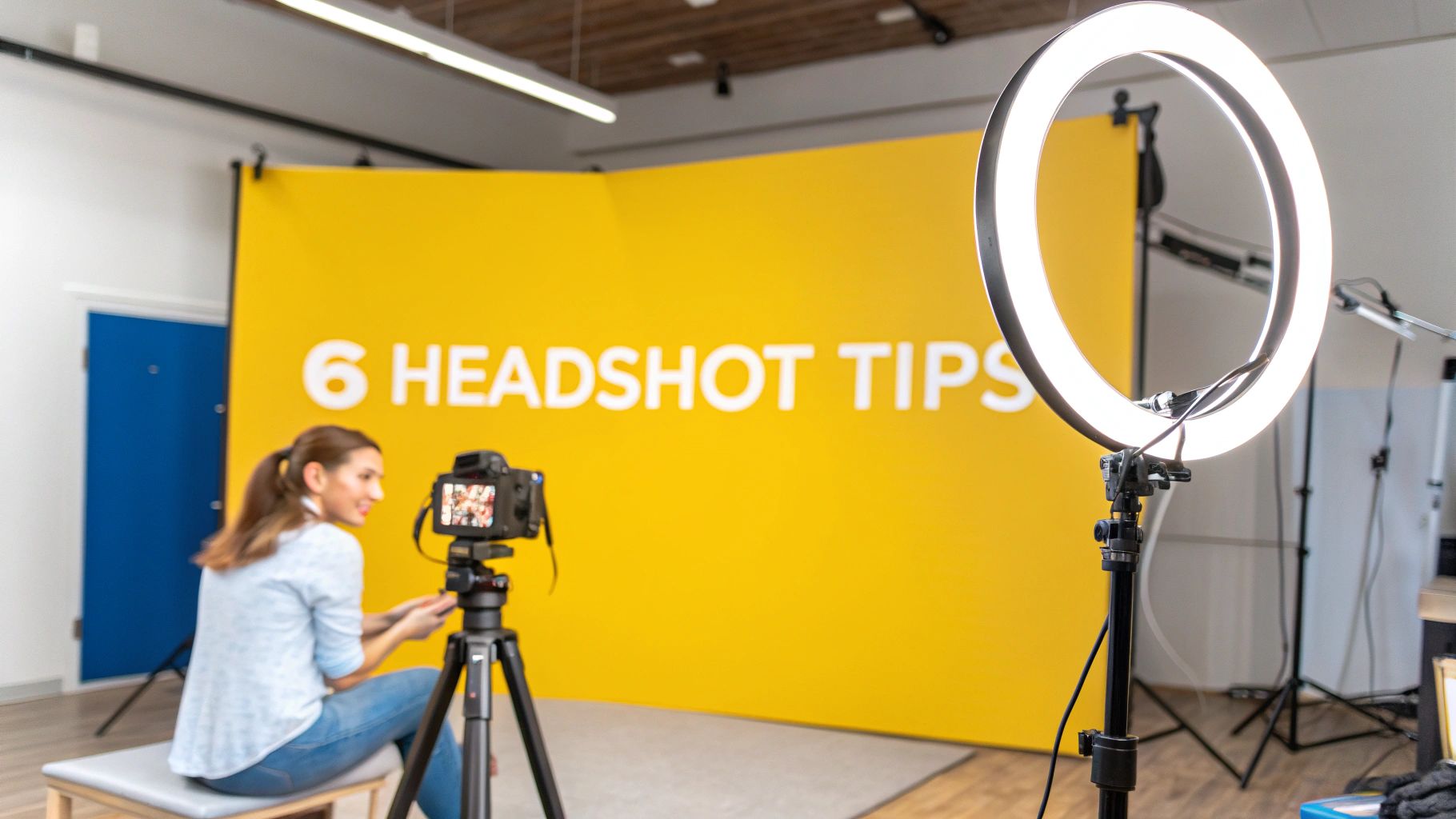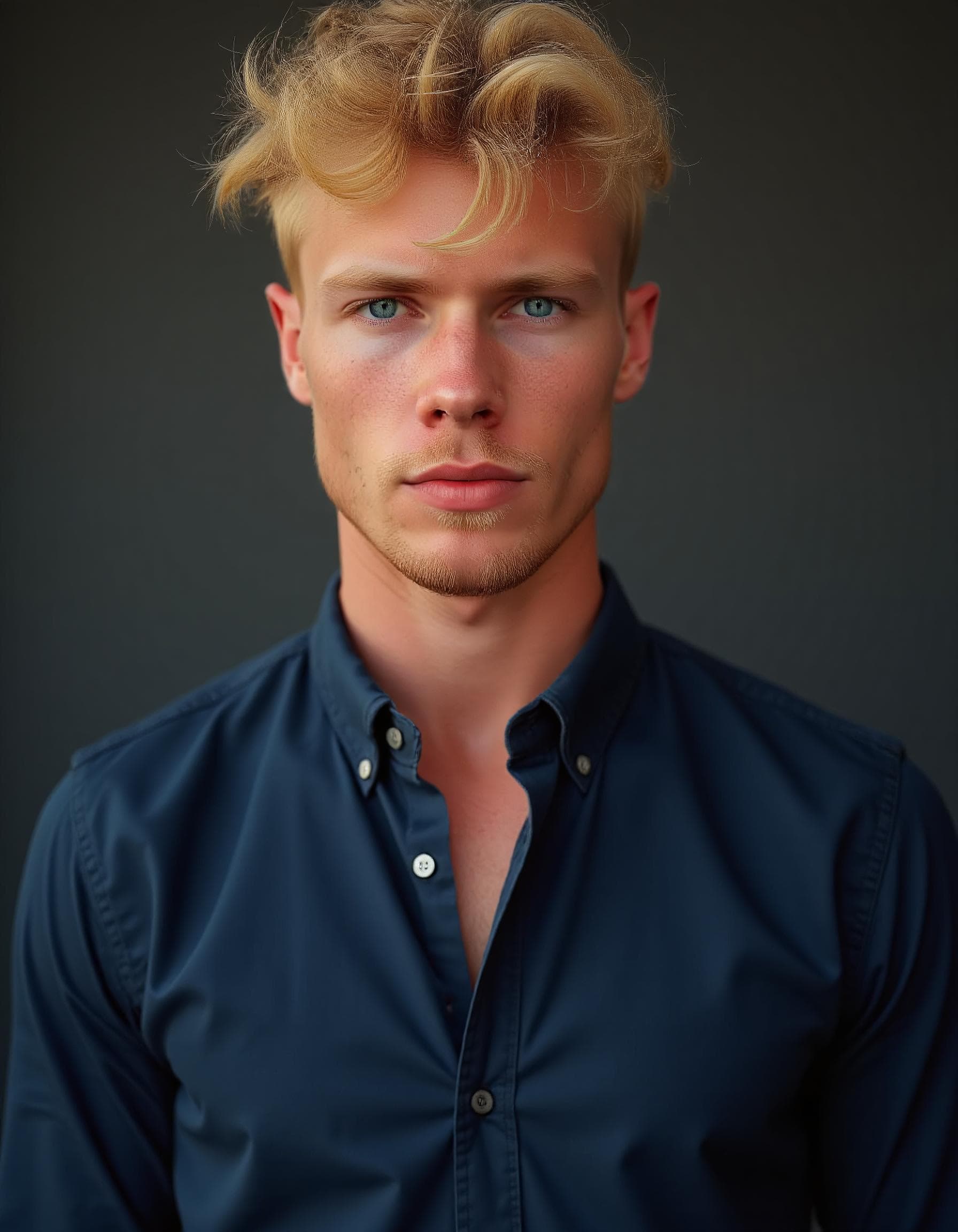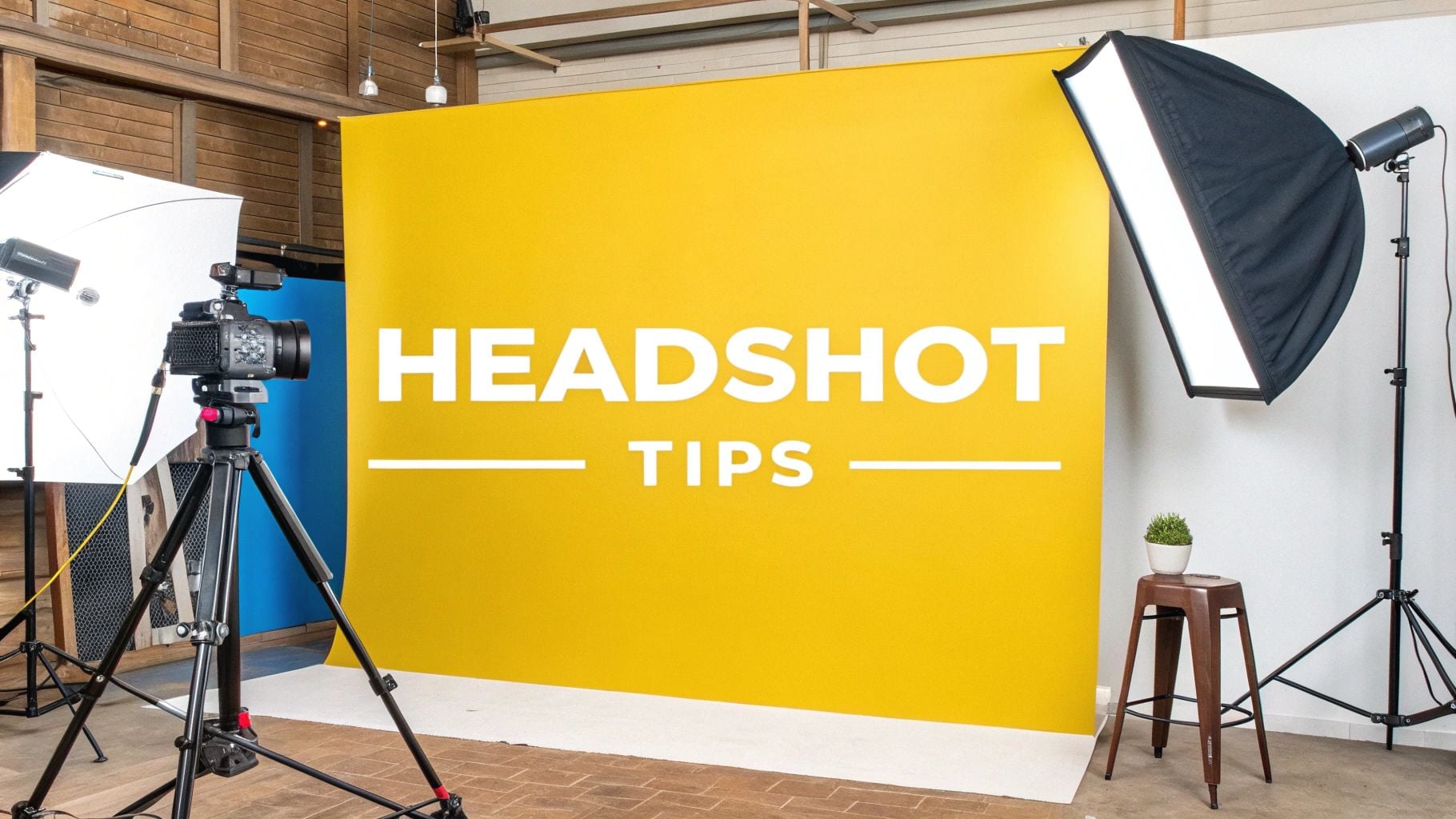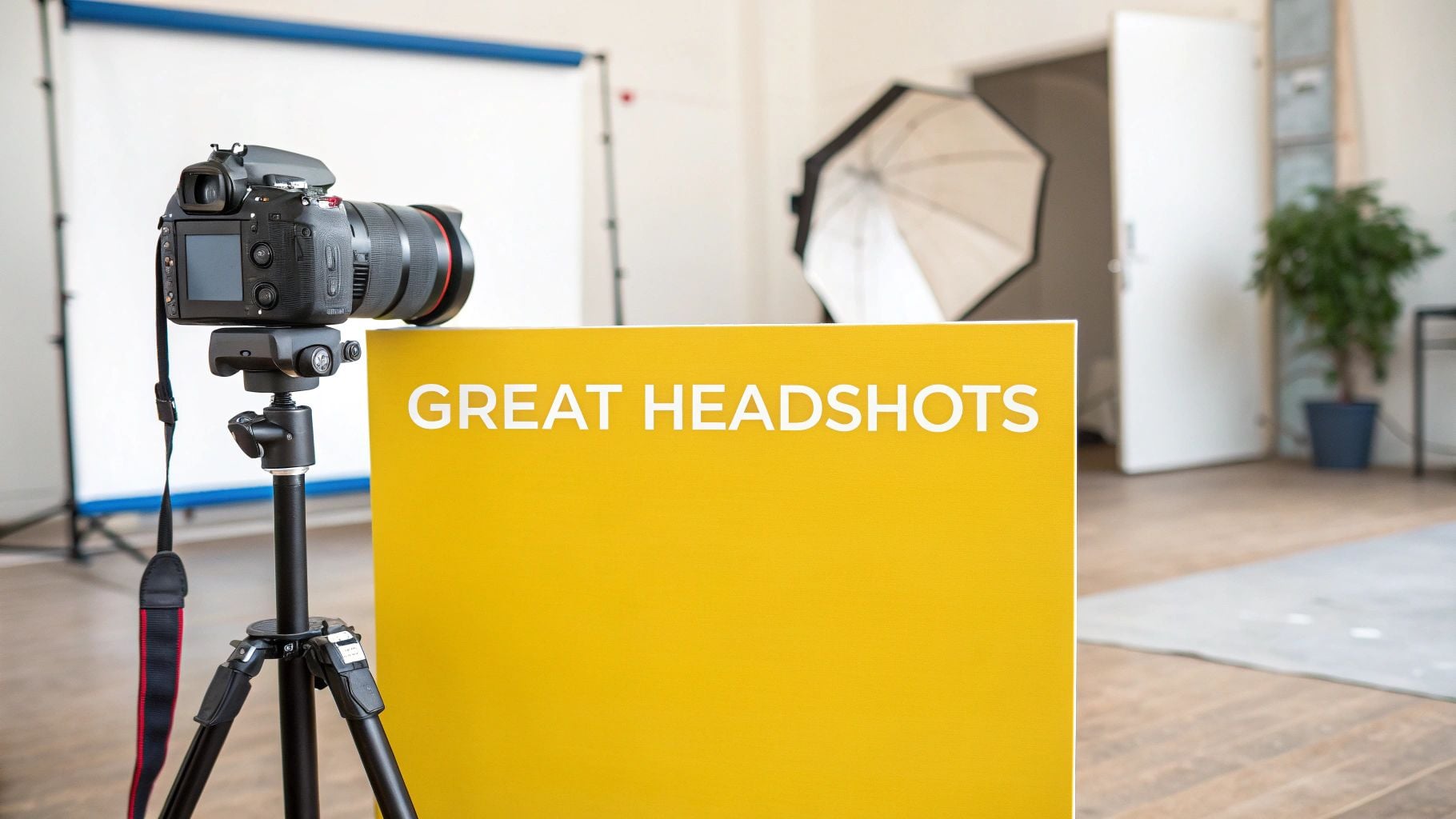In today's digital world, your headshot is often your first introduction. It appears on professional networking sites like LinkedIn, company websites, and resumes, making it a critical part of your personal brand. A high-quality photo communicates professionalism and confidence, while a poor one can create a negative impression before you've even had a chance to connect. But what makes a headshot truly effective?
The difference lies in a few key principles that photographers use to capture their subjects at their best. This guide provides actionable tips for a good headshot, breaking down the most important elements of an outstanding professional image. We'll cover everything from lighting and composition to expression and styling. Whether you are planning a traditional photoshoot or exploring modern solutions like AI-generated headshots, understanding these fundamentals is key to creating a portrait that helps you achieve your goals.
1. Choose Professional Lighting
Lighting does more than just make you visible—it shapes your features, creates depth, and conveys professionalism. One of the most important tips for a good headshot is to use flattering, professional lighting. A common technique involves a key light (the main light source) and a fill light (a softer, secondary light) to illuminate your face evenly and eliminate distracting shadows.
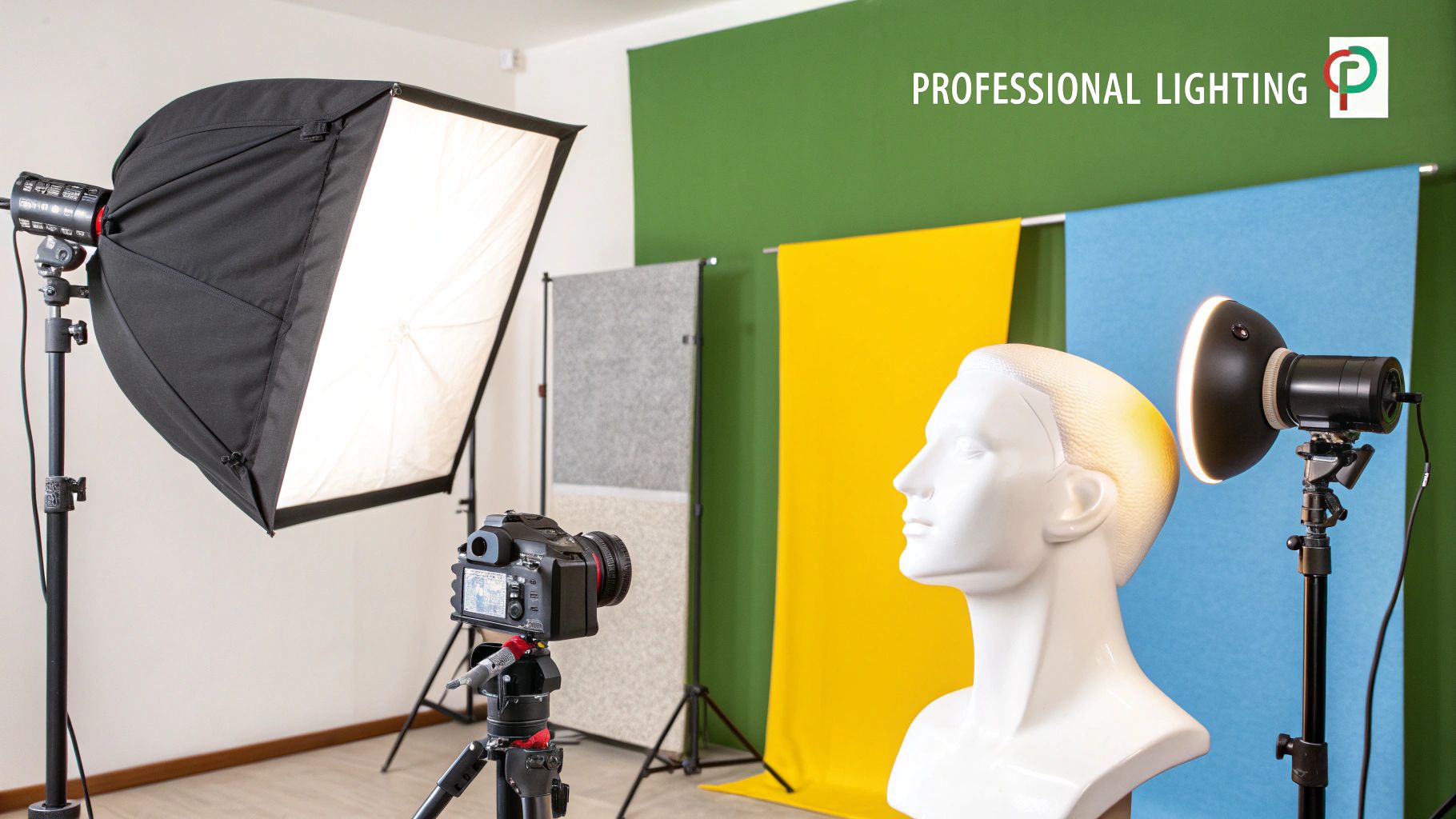
This balanced approach is a standard for corporate profiles, actor headshots, and any professional portrait where clarity and trust are important. A well-lit photo ensures your expression is the main focus, not unflattering shadows under your eyes or nose.
How to Implement Professional Lighting
You don't need an expensive studio to achieve a professional look. You can use natural light or simple tools.
- Natural Light: Position yourself facing a large window on an overcast day. The soft, indirect light from the window acts as an excellent key light.
- DIY Fill Light: To soften shadows on the side of your face opposite the window, use a simple reflector. A large piece of white poster board held on the darker side of your face will bounce light back, "filling in" the shadows.
- Avoid Direct Sun: Harsh, direct sunlight creates hard shadows and causes squinting. It's best to find a shaded area or wait for a day with more cloud cover.
- Studio Setup: If using artificial lights, the key light is typically placed about 45 degrees to the side and slightly above you. The fill light, which should be less intense, is placed on the opposite side to soften the shadows.
Key Insight: The difference between an amateur and a professional headshot often comes down to lighting. Soft, diffused light smooths skin texture and adds a gentle dimension that makes the image look polished and trustworthy.
While setting up physical lighting can be time-consuming, AI-powered tools can create professionally lit portraits from your existing photos. Modern AI can simulate sophisticated lighting setups, giving you a studio-quality look without the hassle.
To see a visual breakdown of how lighting shapes a face, check out this tutorial:
For professionals needing a perfect headshot quickly, technology is a smart alternative. An AI headshot generator can apply these lighting principles for you, ensuring you get a polished and professional result every time.
2. Focus on the Eyes
The eyes are the most important focal point in any headshot. A critical tip for a good headshot is to ensure the eyes are perfectly in focus and create a direct connection with the viewer. This involves using tack-sharp focus on the eyes and establishing clear eye contact with the lens, which translates to engagement and trustworthiness for anyone viewing your photo.
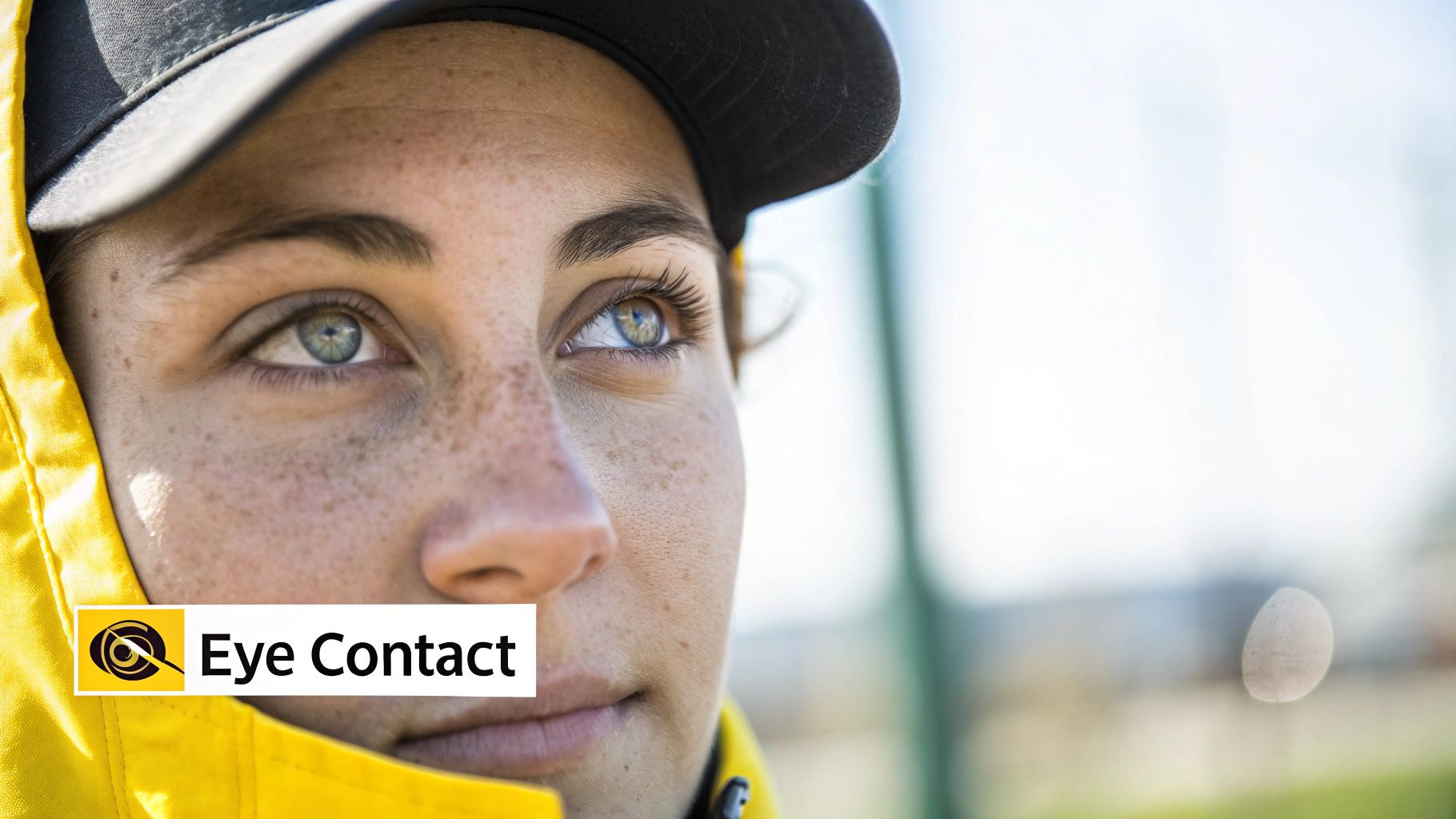
From official portraits of leaders to the headshots of top executives, the power of a direct, focused gaze builds immediate rapport and conveys confidence. When the eyes are sharp, the entire image feels intentional and professional.
How to Achieve Perfect Eye Focus
Achieving a sharp, engaging gaze requires technical precision, whether you are taking the photo or posing for it.
- Use Single-Point Autofocus: If using a camera, set it to single-point AF mode. Place that single focus point directly on the eye closest to the camera. Most modern smartphones do this automatically in portrait mode.
- Prioritize the Nearest Eye: If your head is turned at a slight angle, always focus on the eye that is nearer to the lens. This creates a natural sense of depth and ensures the most important feature is sharp.
- Look for Catchlights: A "catchlight" is the reflection of a light source in the subject's eyes. It adds a spark of life. Ensure your lighting setup creates a small, visible catchlight in your eyes.
- Take Multiple Shots: Take several photos in quick succession while holding your pose. This increases the chances of capturing at least one image where the focus on the eyes is absolutely perfect.
Key Insight: A headshot with soft or out-of-focus eyes immediately looks unprofessional. The viewer's brain is wired to seek eye contact; when it isn’t sharp, the connection is lost.
Manually capturing perfect eye focus can be challenging. This is where technology offers a significant advantage. AI algorithms are trained on millions of portraits and understand the importance of eye sharpness. An AI tool can process your photo to ensure the eyes are the crispest element, creating that essential connection effortlessly.
For a deeper dive into the technical side of achieving sharp focus, this guide is a great resource:
While the traditional approach demands skill and patience, modern solutions can deliver flawless results quickly. For busy professionals who need a compelling, high-quality image, a service like Headyshot guarantees your eyes will be perfectly sharp, helping you make a powerful first impression.
3. Use an Appropriate Background
The background of your headshot sets the tone and provides context. A busy or distracting background can undermine your professionalism. One of the most effective tips for a good headshot is to use a clean, uncluttered background, often combined with a shallow depth of field. This technique creates a soft, blurred background that ensures you are the clear focus of the image.

Whether it's a simple gray backdrop for a corporate profile or a subtly blurred office setting, the goal is the same: eliminate distractions and draw all attention to you. A clean background conveys focus and professionalism.
How to Choose the Right Background
Achieving this professional look requires controlling your environment and camera settings.
- Create Distance: Stand at least a few feet away from your background. This physical separation helps create natural depth and allows the background to fall out of focus.
- Use a Wide Aperture: On a camera, a wide aperture (like f/2.8) narrows the depth of field, keeping you sharp while blurring the background. Most smartphones have a "portrait mode" that simulates this effect.
- Choose Neutral Colors: Select a background that complements your outfit and skin tone. Neutral colors like gray, white, or muted blue are safe and professional choices. Avoid busy patterns or bright colors that compete for attention.
- Keep It Simple: Before shooting, check your background for distracting elements like furniture, wall art, or clutter. A simple, uniform background is almost always the best option.
Key Insight: A blurred background doesn't just look artistic; it psychologically directs the viewer's gaze. By removing environmental distractions, you make a stronger, more immediate connection.
Manually creating the perfect background blur can be challenging without the right equipment. This is where technology provides a significant advantage. AI tools can replicate this effect perfectly, giving you a choice of clean, professional backdrops with an ideal depth of field. This ensures your final image is polished and focused, perfect for platforms like LinkedIn and corporate websites.
4. Perfect Your Expression and Posture
Your expression and posture communicate confidence and approachability. One of the most vital tips for a good headshot is to have an expression that is both authentic and professional, paired with a posture that conveys presence and self-assurance.
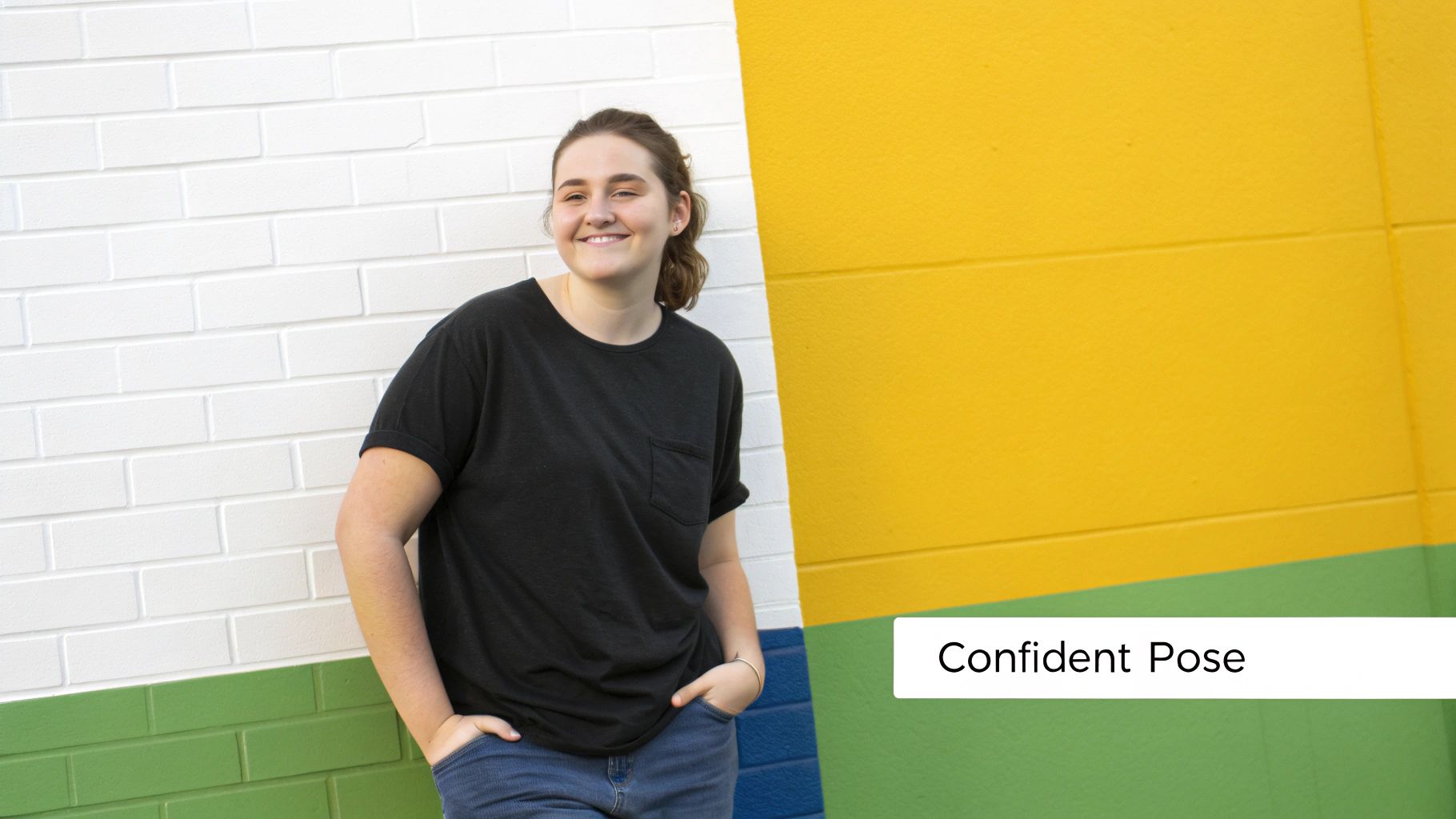
A strong yet relaxed posture combined with a genuine expression helps you look capable and trustworthy, whether you are a consultant aiming for an approachable look or an executive projecting authority.
How to Improve Your Expression and Posture
Achieving a natural look on camera can be challenging, but a few techniques can make a significant difference.
- Practice Your Expression: Stand in front of a mirror and practice the expression you want to convey. Thinking of something that makes you genuinely smile or feel confident can help your expression look more natural.
- Elongate Your Neck: Imagine a string gently pulling the top of your head upward. This helps straighten your spine, relax your shoulders, and create a more confident line.
- Engage with the Camera: Lean your upper body slightly toward the camera. This small movement creates a sense of connection and makes the photo feel more dynamic.
- Try a Subtle Squint: Instead of a wide-eyed look, try slightly narrowing your lower eyelids. This technique, often called a "squinch," can help you look more focused and confident.
Key Insight: The best headshot expressions are not always wide, toothy grins but rather subtle, confident looks that connect through the eyes. It's the difference between looking at the camera and looking through it to the person on the other side.
Getting your posture and expression right during a photoshoot can be difficult. This is another area where AI can help. By analyzing your best selfies, an AI tool can generate a variety of expressions and poses, allowing you to select the one that best captures your professional brand without the pressure of performing on cue.
5. Choose the Right Clothing
Your clothing is a powerful non-verbal cue that communicates your professionalism and industry alignment. A key tip for a good headshot is to select an outfit that enhances your appearance without becoming a distraction. The right clothing should be timeless, well-fitted, and appropriate for your field, allowing your face and expression to take center stage.
From executives in classic suits to creative professionals in smart blazers, a carefully chosen outfit signals attention to detail. It helps viewers immediately understand your professional context.
How to Choose Your Outfit
Selecting the right outfit is a strategic process that balances personal taste with professional standards.
- Opt for Solid Colors: Busy patterns and logos can distract the viewer. Solid colors like navy, charcoal, or forest green are universally flattering and photograph well. To find shades that best complement your features, it can be helpful to explore a comprehensive guide to understanding skin undertone.
- Prioritize Fit: Your clothes should be well-fitted—not too tight or too loose. Make sure your outfit is clean and pressed on the day of the shoot.
- Consider Your Industry: Your attire should reflect your profession. A lawyer might choose a suit, while a graphic designer could opt for a smart-casual look.
- Keep Styling Simple: Jewelry should be minimal and classic. Makeup should be natural but slightly enhanced for the camera. The focus should remain on you, not your accessories. For more ideas, you can find a detailed guide on the best outfits for professional headshots.
Key Insight: The best headshot outfit is one you almost don't notice. It should complement you so effectively that the viewer's attention goes straight to your face and confident expression.
While choosing an outfit is a key part of planning a photoshoot, technology offers a streamlined alternative. AI headshot generators can render you in a variety of professional outfits, allowing you to experiment with different looks without needing a large wardrobe. This is especially useful for professionals who need a range of headshots for different contexts.
6. Use the Right Camera Angle and Composition
The angle and framing of your photo are just as important as the lighting. A good camera angle and composition are among the most vital tips for a good headshot. The optimal angle is typically at eye level or slightly above, which creates flattering facial proportions. Proper composition, often guided by the rule of thirds, ensures the final image is balanced and visually appealing.
This approach is a standard for corporate websites, actor headshots, and speaker profiles because it creates a direct, confident connection. A well-composed headshot frames you as the clear focal point.
How to Implement Proper Angle and Composition
Achieving a professional-looking composition doesn't require complex equipment, just an eye for framing.
- Set the Camera at Eye Level: Position the camera lens directly at or slightly above your eye level. Shooting from below can be unflattering, while a slightly higher angle often helps define the jawline.
- Apply the Rule of Thirds: Imagine a 3x3 grid over your image. Position your eyes along the top horizontal line. This classic technique creates a more dynamic composition than simply centering your face.
- Angle Your Body: Avoid facing the camera straight-on, which can look stiff like a passport photo. Instead, angle your body slightly away from the camera and turn your head back toward the lens. This creates a more dynamic posture.
- Frame for Head and Shoulders: A standard headshot includes your head and the top of your shoulders. Leave a small amount of space above your head but avoid excessive empty space, which can diminish your presence in the frame.
Key Insight: Your pose and framing send non-verbal cues. A proper camera angle and thoughtful composition ensure those cues are of confidence and professionalism.
Getting the perfect angle and composition can be a process of trial and error. Fortunately, AI tools are trained on millions of professionally composed portraits and can apply these principles automatically. An AI headshot generator can produce dozens of perfectly framed options, ensuring you get a polished result.
While you can achieve great composition yourself, technology offers a shortcut to perfection. For a guaranteed professional look, consider using a service like Headyshot to generate flawless, well-composed headshots.
6 Key Tips for Great Headshots Comparison
| Aspect | Choose Professional Lighting (Key Light + Fill Light) | Focus on the Eyes (Sharp Focus + Eye Contact) | Use Appropriate Background and Depth of Field | Perfect Your Expression and Posture | Choose the Right Clothing and Styling | Ensure Proper Camera Angle and Composition |
|---|---|---|---|---|---|---|
| Implementation Complexity | Moderate to high; requires lighting equipment and setup knowledge | Moderate; needs precise autofocus and subject cooperation | Moderate; requires camera aperture control and backdrop setup | Moderate; requires coaching and subject practice | Low to moderate; involves wardrobe selection and preparation | Low to moderate; involves correct camera positioning |
| Resource Requirements | Studio lights or natural light sources, reflectors | Camera with reliable autofocus system | Camera with adjustable aperture, backdrops or suitable location | Practice time, possibly coaching or guidance | Quality clothing, stylist or wardrobe specialist advice | Tripod or steady camera, knowledgeable photographer |
| Expected Outcomes | Even, diffused lighting minimizing shadows and adding depth | Engaging, confident images with sharp, lively eyes | Clean, professional background with pleasing subject separation | Natural, confident expressions and posture | Timeless, polished appearance emphasizing professionalism | Flattering, well-composed headshots with balanced framing |
| Ideal Use Cases | Corporate portraits, actor headshots, business websites | Executive portraits, professional LinkedIn photos | Casting submissions, corporate profiles, professional acting | Therapist photos, legal professionals, client-facing roles | All professional contexts requiring polished attire | Professional portfolios, corporate websites, promotional materials |
| Key Advantages | Professional look, reduces unflattering shadows | Builds connection and trust through eye engagement | Removes distractions, emphasizes subject | Conveys authentic confidence and approachability | Focus on subject’s face, versatile for industries | Creates flattering proportions, follows photography standards |
| Key Challenges | Requires equipment investment and skill | Precise focus difficult; subject discomfort possible | Need for proper aperture knowledge and backdrop management | Can appear forced if over-practiced | Investment in quality clothing; color knowledge required | Needs precise camera height; limited creative flexibility |
Putting It All Together: Your Path to a Perfect Headshot
Creating an effective headshot is about more than just taking a picture; it's about communicating professionalism, confidence, and approachability. By understanding the core elements that make a headshot work, you can create an image that supports your career goals.
Let's recap the key principles. It all starts with professional lighting to sculpt your features without harsh shadows. Next is the critical importance of focusing on the eyes to build an immediate connection. A clean, non-distracting background keeps the attention on you. Your expression and posture send non-verbal cues about your confidence, while your clothing should align with your industry. Finally, proper composition and camera angles frame you in a way that is both flattering and professional.
Integrating the Principles for a Cohesive Image
Each of these tips for a good headshot is a piece of a larger puzzle. A great headshot isn't just about getting one thing right; it's about the seamless integration of all these elements. For example, excellent lighting can highlight a confident expression, and the right composition can draw attention directly to your engaging eye contact. Many of these principles overlap with other photography disciplines. To broaden your understanding of professional photography techniques that can be adapted for headshots, considering these essential event photography tips can offer valuable insights into lighting, composition, and capturing authentic moments.
The value of a great headshot lies in its ability to open doors. It’s your digital handshake on LinkedIn, your first impression on a company's team page, and a vital asset for your personal brand. Investing the effort to get it right is an investment in your career.
The Modern Solution: AI-Powered Perfection
While a traditional photoshoot can yield great results, it often comes with significant costs and time commitments. Fortunately, technology provides a powerful and accessible alternative. AI tools can analyze your existing photos and apply these timeless photography principles, generating a wide variety of studio-quality headshots without you needing to step in front of a camera. This approach is ideal for remote professionals, busy job seekers, and entire teams needing a consistent, high-quality look.
Your professional image is a cornerstone of your career. By applying these tips for a good headshot, you are taking a definitive step toward presenting the best possible version of yourself.
Ready to create a professional headshot without the hassle of a traditional photoshoot? Explore how Headyshot can help. Our AI service uses your existing photos to generate a diverse gallery of high-resolution, studio-quality headshots that put these expert tips into practice, ensuring you make a powerful first impression. Visit the AI Headshot Generator from Headyshot to see how it works.
